Drop 2 chords are the most popular chord voicings in jazz guitar, and serve a wide variety of purposes, including comping, soloing, and chord melody. They have been used by many of the great jazz guitarists including Joe Pass and Wes Montgomery. By understanding how drop 2 chords are built you can quickly learn to play them over the entire neck, and begin to use them to comp or solo over your favorite tunes.
Chances are you are already using drop 2 chords in your guitar playing.
Having a good understanding of drop 2 voicings can be a valuable tool for players of any experience level when comping or improvising a chord solo.
What is a Drop 2 Chord?
Drop 2 chords are seventh chords that are built by dropping the second highest note of a closed position chord down one octave, making that note the bass note of the chord.
Drop 2 chords are open position chords and are important for guitar players because these chords are easy to play on 4 adjacent strings.
In the following example, we start from a Cmaj7 chord in closed position.
The second-highest note is the 5th (G), that is dropped down one octave to create a drop 2 voicing.
The result is a Cmaj7/G (C major seventh with G in the bass). The 7th is moved to the B-string, in order to put the voicing on 4 adjacent strings:
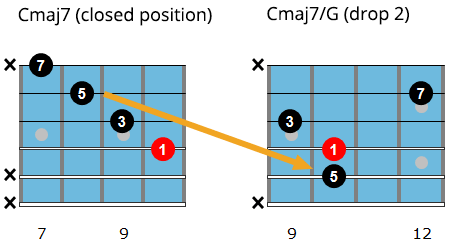
Drop 2 Chord Chart
On the following chord chart, you will find major, dominant, minor, half-diminished, and diminished drop 2 chords and their inversions.

How to Build Drop 2 Chords
Drop 2 chords are built by dropping the second highest note of a four-way close chord to the bass.
In the following example, we make the second highest note (G) of a Cmaj7 chord in root position, one octave lower so it becomes the bass note.
The result is what we call a drop 2 chord:
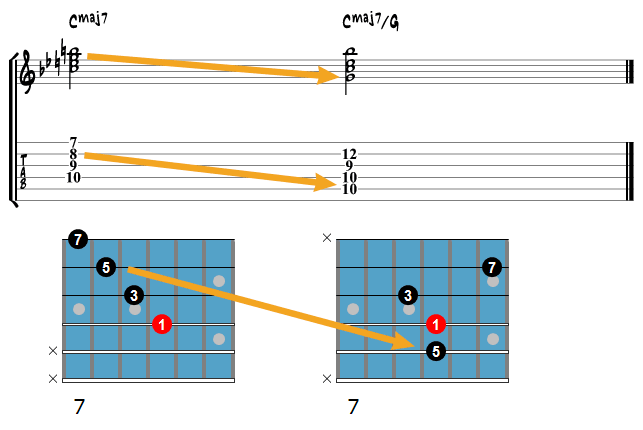
Drop 2 chords are built across adjacent strings (string sets 6543, 5432, and 4321) and have the following intervals:
- Type 1: 1 5 7 3 or C G B E (derived from the 2nd inversion of a chord)
- Type 2: 3 7 1 5 or E B C G (derived from the 3rd inversion of a chord)
- Type 3: 5 1 3 7 or G C E B (derived from a root position chord)
- Type 4: 7 3 5 1 or B E G C (derived from the 1st inversion of a chord)
Note how 1 & 5 and 3 & 7 are always stacked next to each other.
This intervallic arrangement helps give the drop 2 its signature sound.
Fig. 1 shows these four inversions written out in the key of C across the three different string groups:
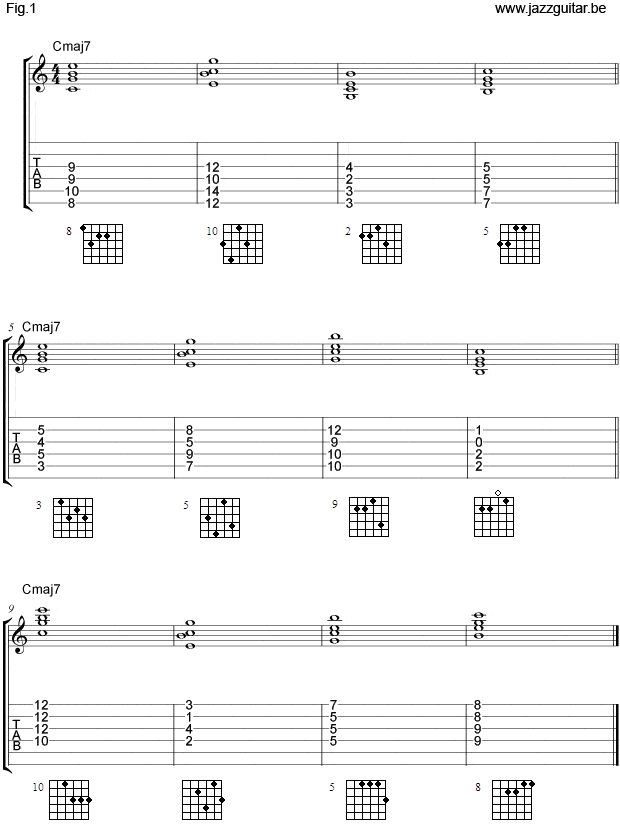
How to Build Common Drop 2 Voicings
Once we have learned to play the different inversions of major seven drop 2 chords across the three string sets, we can begin to check out the other “common” drop 2 chord types.
Learning these different chords can seem like a daunting task, but with a few simple steps, we can play all of these chords with relative ease.
Instead of treating each of these different chords as separate fingerings, we can look at them as variations of the Maj7 chord we already know.
Start by holding the root position CMaj7 chord that we learned in Fig. 1.
Now, by moving only one finger we will turn it into four different types of chords:
By moving the 5 down a fret you’ll have a Cmaj7#11.
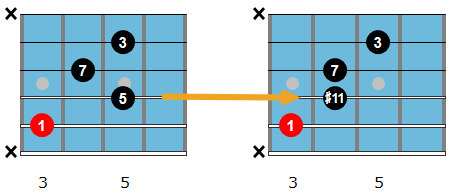
Move the same note (the 5), up a fret and you get a Cmaj7#5.
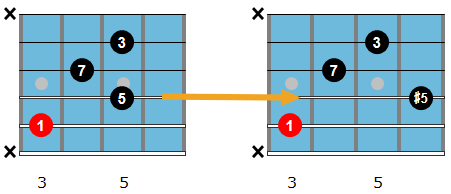
Move the 7 down by a fret and you get a C7.

If you lower the 3 by one fret, you will get a Cm/maj7.
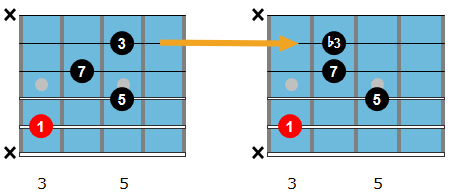
Lower the 3 and 7 by one fret, and you get a Cm7 chord.
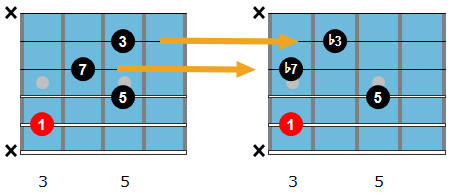
Lower the 3, 5, and 7 by one fret, and you will get a Cm7b5 chord.
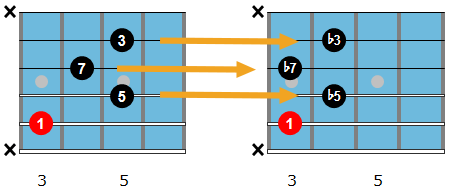
Drop 2 ii V I Exercise
Here’s a good exercise that will help you memorize the drop 2 voicings.
Play the drop 2 chords over a ii V I in C major.
Start with the Dm7 voicing in root position on the 12th fret and descend down the neck, while making as little change possible between chord changes.
The exercise sounds a bit mechanical played like this, but is effective for learning the positions of drop 2 chords on the fretboard.
Backing Track
Listen & Play-along
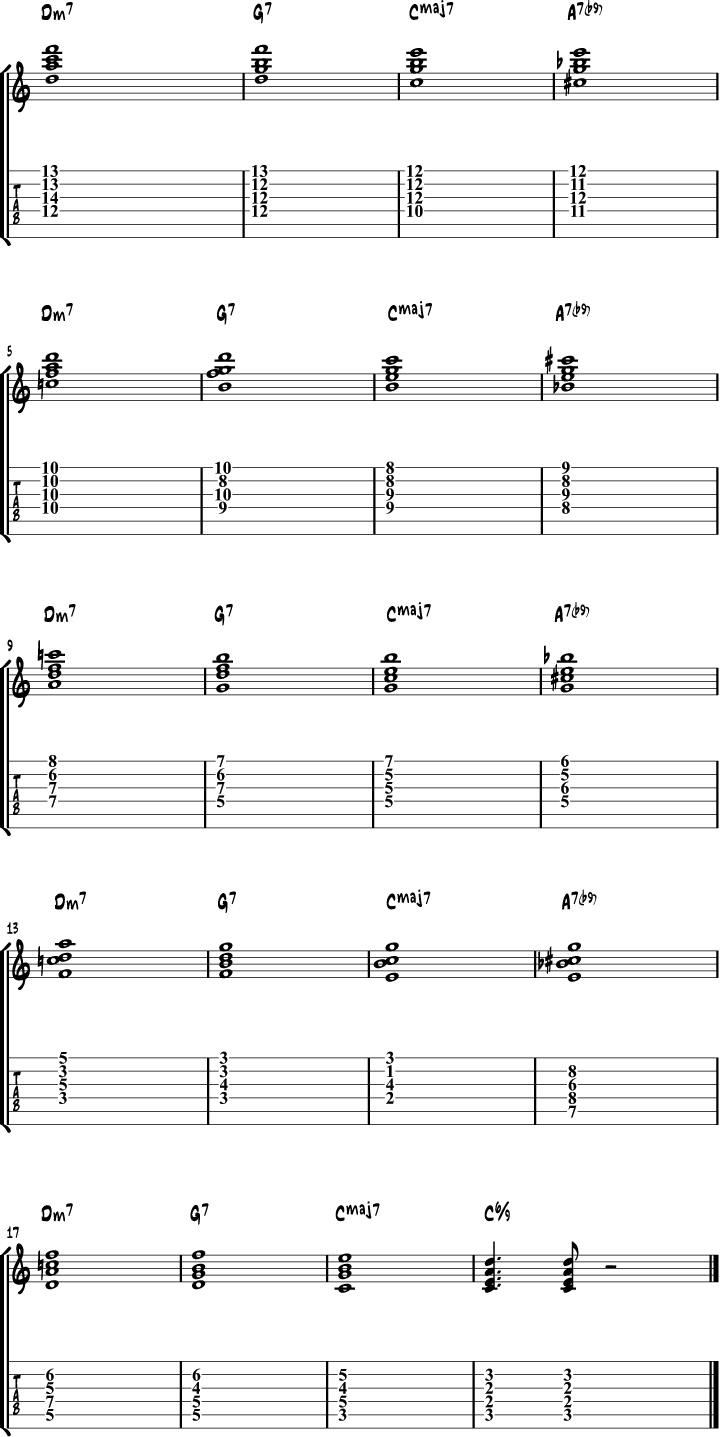
Harmonizing Melodies
Drop 2 chords are often used for harmonizing melodies and chord solos. In the example below, the G major scale (the top note of the chords) is harmonized.
2 things you need to keep in mind when harmonizing melodies:
- Chord tones (in this case G B D F#) are harmonized with major drop 2 voicings (inversions).
- Non-chord tones (in this case A C E) are harmonized with diminished drop 2 voicings.

Variation In Chord Comping
You can use these drop 2 scales to harmonize melodies, do chord solos, but also bring variation in your chord accompaniment.
Here’s an example on a ii V I in G major. All chords used are drop 2 chords, except the Gmaj7 in the third bar, that’s a 4-way close voicing.
To make the D7 chord in the 2nd bar a little more interesting, I made some modifications to the plain drop 2 chord.
Instead of just playing the normal D7/C drop 2 inversion, I exchanged D7’s 5th on the second string with the 13th:
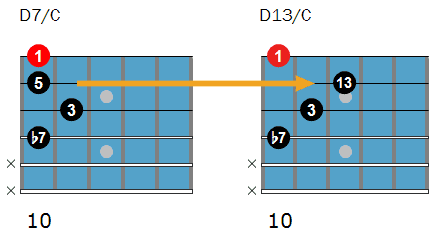
In the next voicing I exchanged D7’s root note with the 9th:
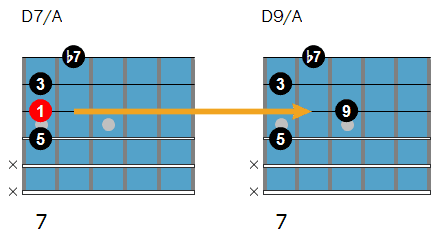
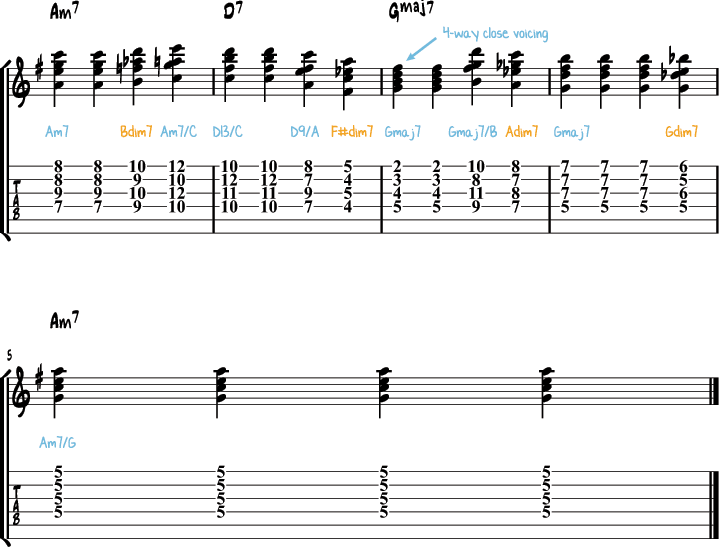
More chord charts:

 Drop 2 Chords PDF
Drop 2 Chords PDF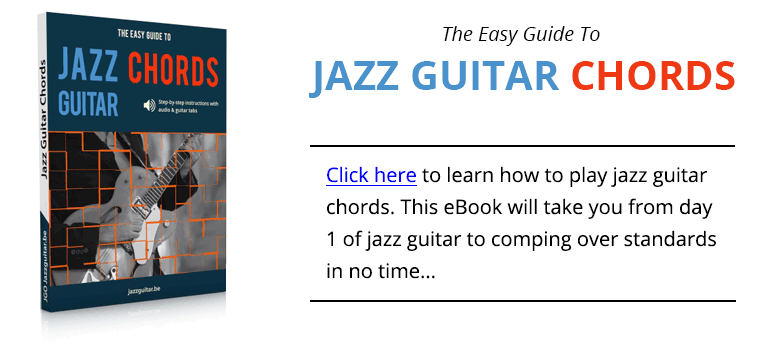

Hello
I would like to buy your method book concerning the Drop 2 chords, major, dominant, minor… but I don’t know which title or title of the book to buy. Could you tell me which book I should buy.
Thanks in advance
Charles
Hi Charles, you mean The Easy Guide to Jazz Guitar Chords and it’s available here: https://www.jazzguitar.be/store/easy-jazz-guitar-chords.php
Hello, what is the functionnality of the Gdim on the last exercice at bar 4 ?
Hi,
At the top it says that drop-2 is where he penultimate note is dropped to the lowest position, but in the section titled “How to Build Common Drop 2 Voicings”, all the examples retain the 1st note as the lowest. Please, what am I missing?
Sean
Hi Sean, the starting chords in the “How to Build Common Drop 2 Voicings” are already drop 2 voicings. In that section, I show how you can make one type of drop 2 chord (Cmaj7 for example) into another type of drop 2 chord (C7 for example).
Hi
Thanks for answering. I did understand that the examples in “How to Build Common Drop 2 Voicings” are designated as already being drop-2. My difficulty is in seeing how they are drop-2 when all of them have the root (or 1st) note as the lowest. At the top you describe drop-2 chords as being where the second highest note is dropped (presuably an octave) to become the lowest note of the chord. The first two diagrams in your page show the shift with the second diagram showing the resultant drop-2 chord with the shifted 5th as the now the lowest. This I understand just fine.
My confusion is with the examples in “How to build Common Drop 2 Voicings” where, at this time of writing, none of the chords have anything but the 1st note as the lowest.
Hi Dirk,
I think I have solved it. From the top of the page:
“Drop 2 chords are seventh chords that are built by dropping the second highest note of a closed position chord down one octave, making that note the bass note of the chord.”
I became fixated on the shifted note becoming the lowest note or “bass note of the chord”. I now gather that this is not necessarily so.
Thank you.
Indeed, I started from a voicing with the root in the bass, but you could start from any inversion to explain the concept.
hi
i am new in jazz
i just wonder why we use dim chord in non-chord tones?
what is the concept?
Hi Shahab, when you harmonize non-chord tones with a diminished chord, you get a dominant b9 voicing that wants to resolve to a chord note, hence creating movement. On Am7 for example, you can harmonize a b-note with a Bdim7 (=Fdim7). The notes B D F Ab are the notes of a E7b9 chord, the dominant of Am7. I hope that makes sense!
Thanks Alex (and Dirk). That’s more food for thought – thinking/seeing/hearing tri-tones, and what they do.
Is there a “better” fingering habit to develop (fingertips vs bar) for the first chord Dm7 (12th fret)?
fingertips 1 4 2 3 vs 1 3 2-2
Also, the Cmaj7 with maj7 in the bass (9th+8th fret)?
fingertips 3 4 1 2 vs 2 3 1-1 (both are comfortable)
maybe the answer is sometimes “depends where you are up and down the fingerboard” or “depends who you ask” 🙂
Hi OJB, I personally prefer the 1 4 2 3 fingering. I’m not a fan of making barres with my second finger, probably because my fingers are too short to do this comfortably. Bottom line, it comes down on personal preference and what feels comfortable to you.
I’m noticing on the exercise there is no A note anywhere on any of the A7(b9) passing chords. Is there a theoretical explanation why?
I suppose I’m seeking a different answer besides:
That’s what the bass player would play; or
It functions as a “6 dominant” to get back to the next ii V I; or
It’s a dim chord and all four of those voicings are used.
The A is actually not that important, the 3rd and 7th are better at defining the chord rather than the root itself. The tension in the chord is in the 3rd and 7th and what makes its defining sound. Consider this question:
What is the difference between an A Major and A Minor chord?
Major: A C# E
Minor: A C E
The only difference is the 3rd. If we simply played the root and 5th, there would be no way to define it as a major or minor. Let ask the same question and add the 7ths:
What is the difference between an Am7 and A7?
Am7: A C E G
A7: A C# E G
You can see that the 7ths are the same here as well. What defines the A7 chord is the tri-tone interval between the 3rd and the 7th. At this point, the root tone A, does not have a large role in the functionality of the chord.
This is also why the vii chord is really just a V7 chord, it is merely the top of a V7 chord with the tri-tone that create all the tension.
Key of D:
vii: C# E G
V7: A C# E G
Since most of these chords are seventh, could you also think of it as dropping the seventh note?
Hi Sharon, you can drop all chord tones. Dropping the seventh means you would start from a first inversion. For example, the first inversion of Cmaj7 in a closed voicing is E G B C. When you drop the second-highest note (b or the 7th) you get B E G C, a drop 2 voicing with the seventh in the bass.
The best lesson yet! Well done! The best explanation of this “theory”yet. A million thanks
Drop 2s have been been my Achilles heel being that, I want to learn them but have NOT devoted the time and effort, however your site is lighting a fire under my Bum, in a good way. With your clear cut examples and no nonsense approach without the over the top theoretical explanations , you make it VERY easy to learn and stay focus. I’m truly diggin’ this site, its locked into my Favorites for life.
Dirk, I would be grateful if you could clarify what is the difference in function between shell voicings, drop 2, and drop 4 chords. Thanks, Ardy
Hi Ardy, these chord types don’t have a function per sé. Choosing between shell, drop 2, or drop 3 comes down to personal preference and the sound needed in a certain setting. Shell chords are often used in 4 to the bar, Freddie Green-type comping. Drop 2 chords are handy for chord solos in the style of Wes Montgomery or playing with a bass player. Drop 3 chords are often used when there is no bass player to accompany a singer for example.
I appreciate the Drop2 lessons, and have done everyone, but I have no idea what’s up here. I think that: from any 4 note cord, I am to take the 2nd highest note from it, then invert the following cord with that 2nd highest note as the lowest note in that following cord. But example 251 indicates something else. I don’t usually have much trouble with your theory lessons, but Drop2 has me baffled. Thanks anyway. I love this site.
Hi Ray, it’s not from any 4-note chord, only from 4-way close chords and inversions. For example C E G B (on strings 1, 2, 3 and 4) becomes G C E B, a drop 2 voicing of Cmaj7 in the second inversion.
Ahhh, What’s a 4-way close chord?
4-way close is a voicing in which all chord tones are within 1 octave.
For example:
7
8
9
10
x
x
Excellent lesson.
Very clear and useful.Thanks
Thanks Dirk! I have been struggling with the chord group 5432 (strings) and this was a great help. In addition the charts for the m7b5 chords were really helpful. Great lesson. jim
Great lesson. Period.
Thanks Dirk. Very good study and helped to clarify the Drop 2 concept.
Your lessons are eye openers to the simplicity of chord forms and their relationships. All it takes is a modicum of understanding and a bunch of thoughtful practice. Have you ever thought of yourself as a ‘hero’?
Great lesson! It’s good to have the diagrams for easy reference—the guitar is such a visual instrument!
Hi, I’m just learning about Jazz theory/chords and this is a fabulous resource! So glad I happened upon it, thanks!
very good lesson Dirk thanks a lot!
Great job, I can finally “see” and understand more with every of your lesson, Thanks again mate.
Awesome lesson!
thanks Dirk.
You’re the best. I am poor and have no money for anything; so thank you for the lessons.
Excellent. So much great info in one lesson. Thanks again.
Thanks Dirk….this info is eye-opening and very helpful.
Great lesson Dirk !!!!
Great stuff, Dirk…
Many thanks !